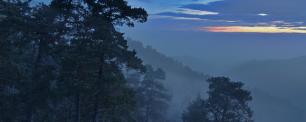Nightime global warming limites CO2 uptake by boreal flora
Nightime temperatures on the planet have increased 1.4 times faster than daytime temperatures. This asymmetry alters carbon fluxes and plant growth in the northern hemisphere, according to a study in which the CREAF is participating.

The rise in temperature that the planet is experiencing has been distributed unevenly throughout the last century. In particular, the minimum temperatures registered during the night have increased 1.4 times more than the highs experienced during the day. This phenomenon has led to the alteration of carbon flows and plant growth in the northern hemisphere, according to an international research in which the CREAF has participated was published today in the journal Nature.
This conclusion emerged from the analysis of data collected over the course of 28 years on the amount, quality and the development of vegetation, as well as maps of the exchange of CO2and of in situ measurements of this gas in the atmospheres of Alaska and Hawaii (both in the United States).
The effects of the increase of the maximum temperatures in both ecosystems were already known. However, according to Peñuelas, "this study highlights that the increase in nightime temperatures must also be taken into account."
In boreal regions, alpine cold and moderately humid, the widespread increase of daytime temperatures (maximum) stimulates the fixation of CO2during daylight hours, but the highest rising temperatures at night (minimum) stimulates even more respiration, thus limiting the capture of CO2. In addition, in temperate and arid regions the opposite effect has been proven, which adds asymmetry to these fluxes, which is directly related to plant growth.
Researcher at the CREAF and CSIC, Josep Peñuelas , the only Spaniard involved in the research, said: "in order to make reliable forecasts and draw conclusions on the functioning of terrestrial ecosystems and their capacity to absorb CO2,we must include essential phenomena like this in our models."
Peng S, Piao S, Ciais P, Myneni RB, Chen A, Chevallier F, Dolman AJ, Janssens Y, Peñuelas J, Zeng H, Zhang G, Vicci S, Wan S, and Wang S (2013) Asymmetric effects of day and night-time warming on Northern Hemispheric vegetation. Nature. DOI: 10.1038/nature12434







